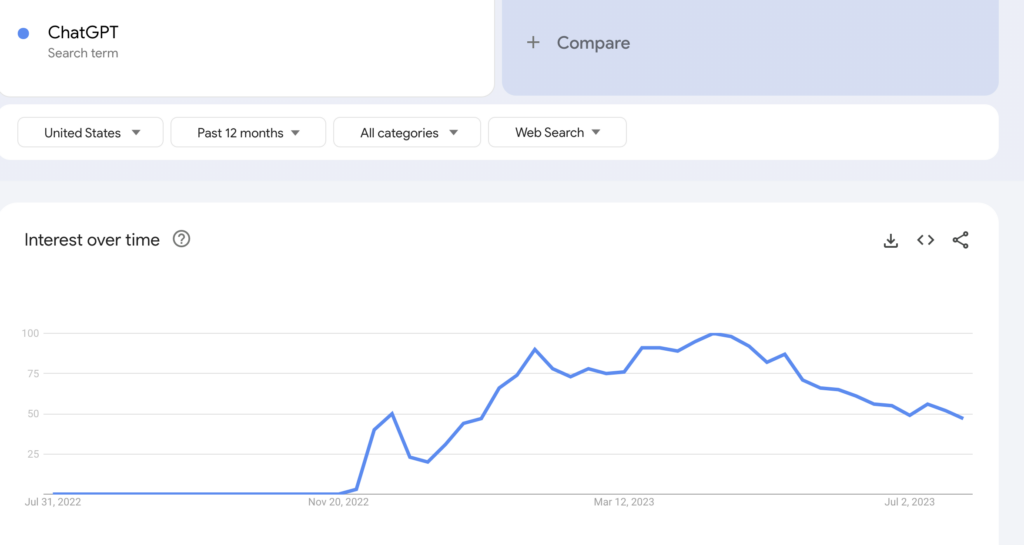Do You Want AI Running Your Amazon PPC Campaigns?

Artificial intelligence is all over the news. Most of us are familiar with seeing it in virtual reality (VR) gaming systems and in images of Elon Musk’s AI robots assembling his Tesla EV automobiles. But, how does it all work?
Is artificial intelligence . . . smart?
We’re asking that question because we’re curious if using the incredible capabilities of AI to help you with your Amazon business is a good thing all around. Or, is it specific to the use case?
Let’s begin with a few definitions.
Thinking About Hiring an Amazon Management Agency?
Canopy’s Partners Achieve an Average 84% Profit Increase!
Let’s talkWhat is Artificial Intelligence?
Most people consider AI to be any technology that demonstrates what is considered to be human behavior. That might mean abilities such as learning, reasoning, or adaptation to circumstances. AI comprises a number of derivative technologies such as machine learning, data modeling, and data mining.
Machine learning, data mining, and data modeling are all part of artificial intelligence. They use data to make predictions or take actions. They’re particularly effective in data-heavy situations such as engineering, digital marketing and ecommerce. In almost every case, more data equals better results.
How Does AI Help Amazon Sellers?
Artificial intelligence is good at analyzing large amounts of data and predicting similar outcomes. That’s why it’s a useful tool for writing multiple sales or listing copies quickly for brands wanting to save time.
The problem with that is most Amazon sellers would gladly trade quantity for quality every day of the week. With the maturing of the Amazon marketplace and the increased sophistication of sellers, to succeed, you need to be good.
“Fast” isn’t enough to help you to stand out.
Artificial intelligence and machine learning tend to thrive best in periods of relative calm and when presented with regular and predictable data sets. That doesn’t sound like an Amazon PPC campaign.
The Bumpy E-Commerce Road Can Throw AI for a Loop
If recent global conditions have taught us anything, it’s that Amazon sellers should always expect the unexpected. From supply chain disruptions, to Amazon PPC marketing, the last few years have been particularly unpredictable.
Life’s bumpy road tends to throw algorithms for a loop. But, it’s more than that.
Using AI and machine learning to help optimize your Amazon product listings or automate your PPC campaign is a little like getting all your news from Facebook. It becomes an ever tightening circle of information.
The ancient symbol, Ouroboros is often depicted as a snake eating its own tail. In much the same way, Facebook’s algorithm continually filters the news in your feed until there’s almost nothing that you find objectionable. Everything is strikingly alike.
Sort of like this Amazon product listing.

What’s the problem with that, you might ask?
Avoid the Amazon Crowd with Long Tail Keywords
A little diversity of opinion is a good thing, period. In Amazon advertising, the top PPC experts can increase sales by emphasizing product distinctions. That kind of unique marketing strategy has a lot to do with long tail keywords.
Long tail keywords allow Amazon PPC management agencies (and Amazon sellers) to drill down into a specific niche. Long tail keywords are also found MUCH LOWER in the marketing funnel.
Right down where target audiences start becoming buyers!
Artificial intelligence and machine learning aren’t going away any time soon. The problem with using AI with Amazon pay per click advertising strategy is that artificial intelligence is much more comfortable with shorter, seed keywords.
AI and machine learning programs use existing data to develop predictive models. The more data, the more precise the modeling becomes. Unfortunately, more data also means that you’re probably following large crowds of Amazon sellers marketing similar products.
How Do Long Tail Keywords Help Amazon Sellers Rank Higher?
With listing optimization, you don’t have to pay for popular keywords like you do with Amazon PPC advertising. It’s a cost effective strategy. Why not use them in your listings? That’s because in two very important and related ways, they could be costing you significantly.
If you’re not specific enough about the product that you’re selling, sellers are not going to click on your listings AND your click-through-rate (CTR) is going to suffer.
That’s where long tail keywords come in.
By making sure to optimize your titles, bullet points, descriptions, and listing backend with long tail keywords, the right shoppers will click on your listings. That will lead to higher CTR, a higher ranking on Amazon, and more sales.
Just showing up at the top of Amazon’s search results isn’t enough.
Yes, you want to show up high in the search results for shoppers who are looking for a product exactly like yours. Otherwise, all that optimization work is wasted.
Long Tail Keywords and Amazon PPC Strategy
Amazon PPC services put a lot of effort into creating long tail keyword strategies.
They do so for three big reasons:
- Lower competition
- A lower cost per click
- Higher PPC conversion rates
Let’s consider the short tail keyword, “standing desk.” I’m going to open Helium 10’s keyword research tool, Magnet and take a closer look at it.

With a search volume of 370,751, it’s clear that if you choose to sell a standing desk on Amazon, you won’t be the only one. The word frequency (on the right side of the screenshot) gives us a pretty good idea of the words that most often make up the longer keyword phrases.
Magnet also gives you the full list of all the search terms that are closely associated with “standing desk.” As you can see, if I was the Amazon seller trying to sell an “electric height adjustable desk,” I wouldn’t have nearly as much competition.

More to the point, the chances that an Amazon customer looking for exactly that, would be more likely to purchase. That makes both Amazon AND the customer happy.
Ultimately, that’s Amazon’s goal.
Strangely enough, this list of ranked keyword phrases demonstrates another tactic that many skilled Amazon sellers take advantage of. I’ll admit it. Sometimes if I’m moving too quickly, I’ll accidentally misspell a word.
Amazon shoppers do too!

That’s why many Amazon advertising services will place misspelled versions of important keyword phrases (both long and short tail) in the listing’s back end.
For example, including the keyword phrase, “shapred desk,” a misspelling of “shaped desk” could get you competition-free access to 348 Amazon shoppers.
Why You Might Want a Human at the Controls
Using AI automation for your Amazon PPC ad can be a powerful tool for optimizing bids for short tail keywords with high search volume. Because all that keyword data is the result of repetitive sales, machine-learning algorithms are able to make sense of the information.
These shorter tail keywords are most often used to increase brand awareness, making your product known to a very large number of prospective buyers at the top of the advertising funnel. The top of the funnel is also home to an enormous amount of competition and poor conversion rates.
Spending a lot of PPC dollars simply to advertise your product with Amazon ads is a good way to waste a lot of money. You want to be spending your PPC marketing dollars on an ad campaign that converts.
Amazon sellers really want to be taking advantage of the higher conversion rates and lower ad spend that occupies the bottom of the funnel. That kind of high-level PPC optimization strategy is where an Amazon PPC agency like Canopy Management comes in.

Amazon Agency Skills + AI Offers the Best of Both Worlds
When ChatGPT first exploded onto the scene, there was a lot of interest from pretty much everyone looking to supercharge their ability to get stuff done. Then, they quickly realized that to get the most from AI, it’s important to input the correct, industry-specific prompts.
Canopy Management isn’t technology adverse. The difference is this: Canopy uses software to free up the bandwidth of our Amazon-selling experts. We love a good piece of technology as much as the next person. But, it’s a tool, nothing more.
Our most extraordinary resources are our teams of e-commerce experts that are producing amazing creative assets, fully optimizing listings, and closely monitoring custom PPC and Amazon DSP advertising campaigns.
What would adding 67% more organic sales mean for your brand?
Turns out that when you combine the massive experience of Canopy’s Amazon Advertising Experts with smart tools and tech, you get industry-leading results like this:
- 84% Average Year-Over-Year Profit Growth for Our Partners
- 2.7 Billion in Revenue Managed
- 99.1% Partner Retention Rate
Canopy Management is a full-service marketing agency for Amazon and Walmart sellers. Our team consists of former Amazonians, multi-million dollar sellers, and award-winning experts.
When you consider the many ways that Canopy Management can help you grow your business, you’ll see why selling on Amazon is much easier “under the Canopy.”
- Strategic Growth Planning
- Listing Copywriting Optimization
- Listing Photography
- Product Videography
- Advertising Management
- Customer Service
- Demand Side Platform (Amazon DSP)
- Amazon Posts
- Full Service Management
- Amazon Review Aggregation



